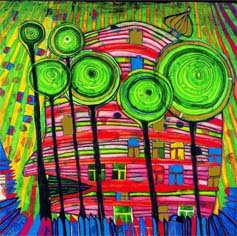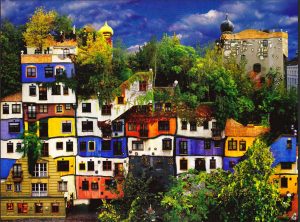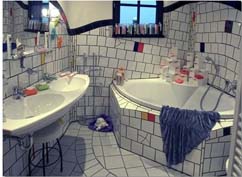Clyde Binfield is the Emeritus Professor of History at the University of Sheffield with several books to his name. He is also a very accomplished speaker with both a sense of humour and great curiosity. Perhaps his love of an artist/architect that was so anti-establishment and a hero of the working man should not come as a surprise.
Tourists to Vienna will be aware of this most eccentric man, whilst the rest of us may not have heard of him. Friedrich Stowasser was born in 1928. In 1948 he joined a Academy of Fine Arts in Vienna only to leave after 3 months and a few months later he changed his name to Hundertwasser
As an artist he was very much influenced by the Norwegian painter Edvard Munch but he also had strong “green” sympathies. He had an aversion to the uniformity of straight lines and described modern architecture as degenerate.
In his painting of his famous Hundertwasserhaus , the building has no straight lines and greenery, especially trees predominate. At this time when the double helix of DNA was discovered, he was painting spirals. Through his art he tried to reveal the possibilities of a better world with safe environment and protected nature
In 1952 he held his first major exhibition in Vienna. The main theme in his paintings is the reconciliation and harmony of mankind with nature.
At the age of 55, he became embroiled with architecture. The above photograph is a block of social housing now called Hundertwasserhaus. It is an important building on the Vienna tourist circuit and is very popular with its occupants. It’s a “make over” of an existing block whose original wall can be seen exposed in the left corner. He appears to have got on well with craftsmen. The photograph of a typical bathroom shows how the building has been transformed.
In 1959 he became an Associate professor at Hamburg University. In 1968 he was lecturing about the 3 skins. The 1st. skin is the naked skin, 2nd skin is our clothes and 3rd skin is the home we live in. At times he would be naked whilst delivery these lectures.
Besides paintings and buildings he was famous for his poster and stamp designs. He made his own clothes and had a pink hat!
He travelled extensively and spent his later years in New Zealand where he had dual citizenship and he died whilst cruising on the QE2 in February 2000.
This is a spell binding talk about a man that simply oozes creativity and refuses to be constrained by rules.




